Qing Lyu
Shammie
Joint Beamforming and Integer User Association using a GNN with Gumbel-Softmax Reparameterizations
Jun 05, 2025Abstract:Machine learning (ML) models can effectively optimize a multi-cell wireless network by designing the beamforming vectors and association decisions. Existing ML designs, however, often needs to approximate the integer association variables with a probability distribution output. We propose a novel graph neural network (GNN) structure that jointly optimize beamforming vectors and user association while guaranteeing association output as integers. The integer association constraints are satisfied using the Gumbel-Softmax (GS) reparameterization, without increasing computational complexity. Simulation results demonstrate that our proposed GS-based GNN consistently achieves integer association decisions and yields a higher sum-rate, especially when generalized to larger networks, compared to all other fractional association methods.
Nonhuman Primate Brain Tissue Segmentation Using a Transfer Learning Approach
Apr 01, 2025Abstract:Non-human primates (NHPs) serve as critical models for understanding human brain function and neurological disorders due to their close evolutionary relationship with humans. Accurate brain tissue segmentation in NHPs is critical for understanding neurological disorders, but challenging due to the scarcity of annotated NHP brain MRI datasets, the small size of the NHP brain, the limited resolution of available imaging data and the anatomical differences between human and NHP brains. To address these challenges, we propose a novel approach utilizing STU-Net with transfer learning to leverage knowledge transferred from human brain MRI data to enhance segmentation accuracy in the NHP brain MRI, particularly when training data is limited. The combination of STU-Net and transfer learning effectively delineates complex tissue boundaries and captures fine anatomical details specific to NHP brains. Notably, our method demonstrated improvement in segmenting small subcortical structures such as putamen and thalamus that are challenging to resolve with limited spatial resolution and tissue contrast, and achieved DSC of over 0.88, IoU over 0.8 and HD95 under 7. This study introduces a robust method for multi-class brain tissue segmentation in NHPs, potentially accelerating research in evolutionary neuroscience and preclinical studies of neurological disorders relevant to human health.
Synthesizing beta-amyloid PET images from T1-weighted Structural MRI: A Preliminary Study
Sep 26, 2024


Abstract:Beta-amyloid positron emission tomography (A$\beta$-PET) imaging has become a critical tool in Alzheimer's disease (AD) research and diagnosis, providing insights into the pathological accumulation of amyloid plaques, one of the hallmarks of AD. However, the high cost, limited availability, and exposure to radioactivity restrict the widespread use of A$\beta$-PET imaging, leading to a scarcity of comprehensive datasets. Previous studies have suggested that structural magnetic resonance imaging (MRI), which is more readily available, may serve as a viable alternative for synthesizing A$\beta$-PET images. In this study, we propose an approach to utilize 3D diffusion models to synthesize A$\beta$-PET images from T1-weighted MRI scans, aiming to overcome the limitations associated with direct PET imaging. Our method generates high-quality A$\beta$-PET images for cognitive normal cases, although it is less effective for mild cognitive impairment (MCI) patients due to the variability in A$\beta$ deposition patterns among subjects. Our preliminary results suggest that incorporating additional data, such as a larger sample of MCI cases and multi-modality information including clinical and demographic details, cognitive and functional assessments, and longitudinal data, may be necessary to improve A$\beta$-PET image synthesis for MCI patients.
Cross-Institutional Structured Radiology Reporting for Lung Cancer Screening Using a Dynamic Template-Constrained Large Language Model
Sep 26, 2024Abstract:Structured radiology reporting is advantageous for optimizing clinical workflows and patient outcomes. Current LLMs in creating structured reports face the challenges of formatting errors, content hallucinations, and privacy leakage concerns when uploaded to external servers. We aim to develop an enhanced open-source LLM for creating structured and standardized LCS reports from free-text descriptions. After institutional IRB approvals, 5,442 de-identified LCS reports from two institutions were retrospectively analyzed. 500 reports were randomly selected from the two institutions evenly and then manually labeled for evaluation. Two radiologists from the two institutions developed a standardized template including 29 features for lung nodule reporting. We proposed template-constrained decoding to enhance state-of-the-art open-source LLMs, including LLAMA, Qwen, and Mistral. The LLM performance was extensively evaluated in terms of F1 score, confidence interval, McNemar test, and z-test. Based on the structured reports created from the large-scale dataset, a nodule-level retrieval system was prototyped and an automatic statistical analysis was performed. Our software, vLLM-structure, is publicly available for local deployment with enhanced LLMs. Our template-constrained decoding approach consistently enhanced the LLM performance on multi-institutional datasets, with neither formatting errors nor content hallucinations. Our method improved the best open-source LLAMA-3.1 405B by up to 10.42%, and outperformed GPT-4o by 17.19%. A novel nodule retrieval system was successfully prototyped and demonstrated on a large-scale multimodal database using our enhanced LLM technologies. The automatically derived statistical distributions were closely consistent with the prior findings in terms of nodule type, location, size, status, and Lung-RADS.
Avoiding Copyright Infringement via Machine Unlearning
Jun 16, 2024Abstract:Pre-trained Large Language Models (LLMs) have demonstrated remarkable capabilities but also pose risks by learning and generating copyrighted material, leading to significant legal and ethical concerns. To address these issues, it is critical for model owners to be able to unlearn copyrighted content at various time steps. We explore the setting of sequential unlearning, where copyrighted content is removed over multiple time steps - a scenario that has not been rigorously addressed. To tackle this challenge, we propose Stable Sequential Unlearning (SSU), a novel unlearning framework for LLMs, designed to have a more stable process to remove copyrighted content from LLMs throughout different time steps using task vectors, by incorporating additional random labeling loss and applying gradient-based weight saliency mapping. Experiments demonstrate that SSU finds a good balance between unlearning efficacy and maintaining the model's general knowledge compared to existing baselines.
Calibrating Large Language Models with Sample Consistency
Feb 21, 2024Abstract:Accurately gauging the confidence level of Large Language Models' (LLMs) predictions is pivotal for their reliable application. However, LLMs are often uncalibrated inherently and elude conventional calibration techniques due to their proprietary nature and massive scale. In this work, we explore the potential of deriving confidence from the distribution of multiple randomly sampled model generations, via three measures of consistency. We perform an extensive evaluation across various open and closed-source models on nine reasoning datasets. Results show that consistency-based calibration methods outperform existing post-hoc approaches. Meanwhile, we find that factors such as intermediate explanations, model scaling, and larger sample sizes enhance calibration, while instruction-tuning makes calibration more difficult. Moreover, confidence scores obtained from consistency have the potential to enhance model performance. Finally, we offer practical guidance on choosing suitable consistency metrics for calibration, tailored to the characteristics of various LMs.
Hunting imaging biomarkers in pulmonary fibrosis: Benchmarks of the AIIB23 challenge
Dec 21, 2023
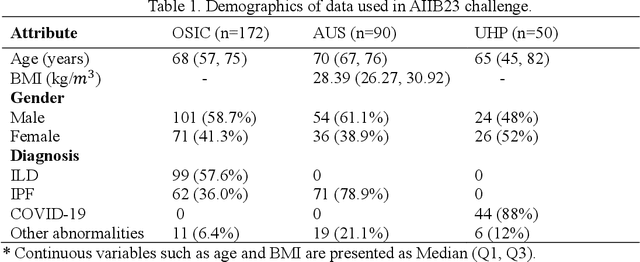
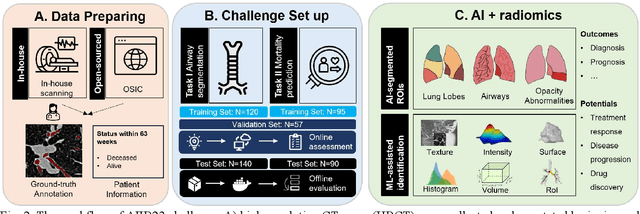
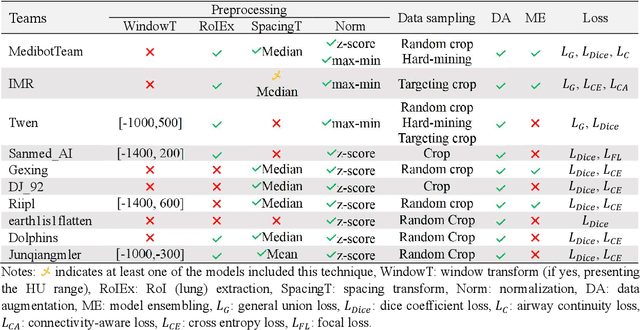
Abstract:Airway-related quantitative imaging biomarkers are crucial for examination, diagnosis, and prognosis in pulmonary diseases. However, the manual delineation of airway trees remains prohibitively time-consuming. While significant efforts have been made towards enhancing airway modelling, current public-available datasets concentrate on lung diseases with moderate morphological variations. The intricate honeycombing patterns present in the lung tissues of fibrotic lung disease patients exacerbate the challenges, often leading to various prediction errors. To address this issue, the 'Airway-Informed Quantitative CT Imaging Biomarker for Fibrotic Lung Disease 2023' (AIIB23) competition was organized in conjunction with the official 2023 International Conference on Medical Image Computing and Computer Assisted Intervention (MICCAI). The airway structures were meticulously annotated by three experienced radiologists. Competitors were encouraged to develop automatic airway segmentation models with high robustness and generalization abilities, followed by exploring the most correlated QIB of mortality prediction. A training set of 120 high-resolution computerised tomography (HRCT) scans were publicly released with expert annotations and mortality status. The online validation set incorporated 52 HRCT scans from patients with fibrotic lung disease and the offline test set included 140 cases from fibrosis and COVID-19 patients. The results have shown that the capacity of extracting airway trees from patients with fibrotic lung disease could be enhanced by introducing voxel-wise weighted general union loss and continuity loss. In addition to the competitive image biomarkers for prognosis, a strong airway-derived biomarker (Hazard ratio>1.5, p<0.0001) was revealed for survival prognostication compared with existing clinical measurements, clinician assessment and AI-based biomarkers.
LEOD: Label-Efficient Object Detection for Event Cameras
Nov 29, 2023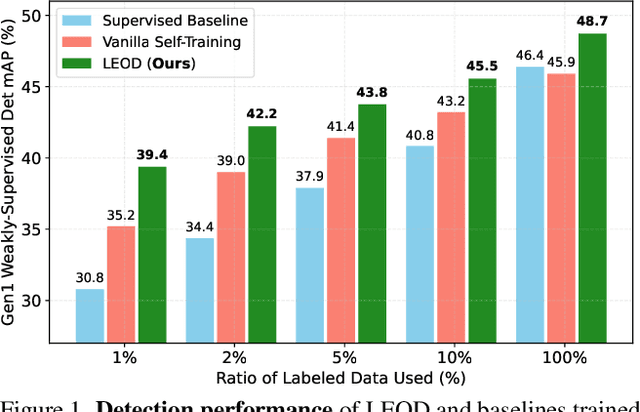
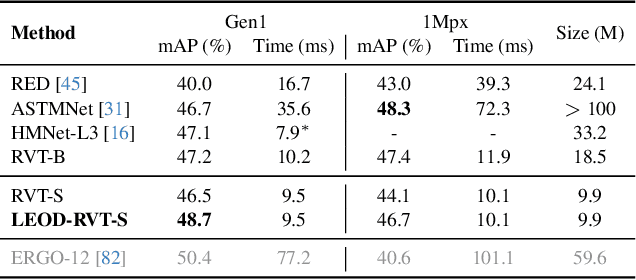
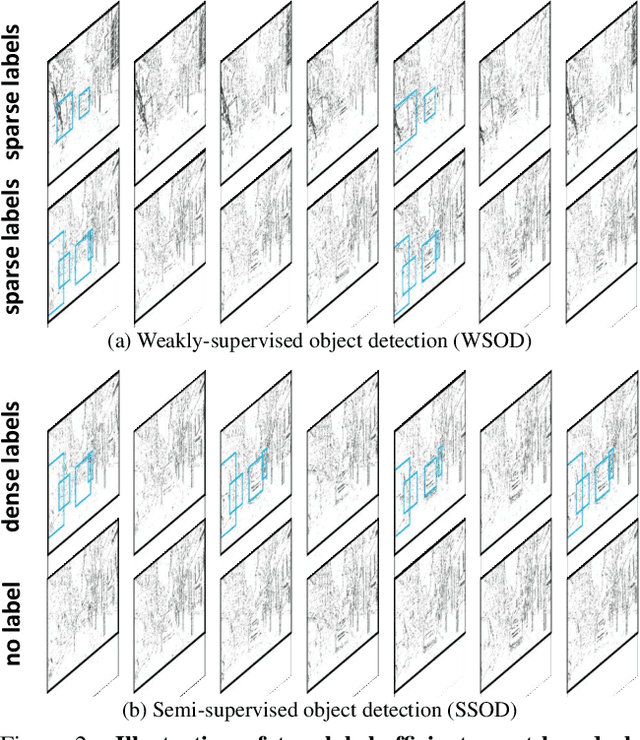
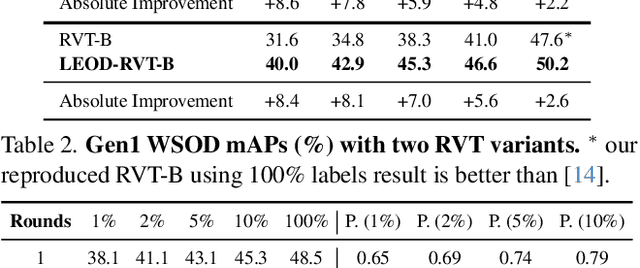
Abstract:Object detection with event cameras enjoys the property of low latency and high dynamic range, making it suitable for safety-critical scenarios such as self-driving. However, labeling event streams with high temporal resolutions for supervised training is costly. We address this issue with LEOD, the first framework for label-efficient event-based detection. Our method unifies weakly- and semi-supervised object detection with a self-training mechanism. We first utilize a detector pre-trained on limited labels to produce pseudo ground truth on unlabeled events, and then re-train the detector with both real and generated labels. Leveraging the temporal consistency of events, we run bi-directional inference and apply tracking-based post-processing to enhance the quality of pseudo labels. To stabilize training, we further design a soft anchor assignment strategy to mitigate the noise in labels. We introduce new experimental protocols to evaluate the task of label-efficient event-based detection on Gen1 and 1Mpx datasets. LEOD consistently outperforms supervised baselines across various labeling ratios. For example, on Gen1, it improves mAP by 8.6% and 7.8% for RVT-S trained with 1% and 2% labels. On 1Mpx, RVT-S with 10% labels even surpasses its fully-supervised counterpart using 100% labels. LEOD maintains its effectiveness even when all labeled data are available, reaching new state-of-the-art results. Finally, we show that our method readily scales to improve larger detectors as well.
Interpretable-by-Design Text Classification with Iteratively Generated Concept Bottleneck
Oct 30, 2023



Abstract:Deep neural networks excel in text classification tasks, yet their application in high-stakes domains is hindered by their lack of interpretability. To address this, we propose Text Bottleneck Models (TBMs), an intrinsically interpretable text classification framework that offers both global and local explanations. Rather than directly predicting the output label, TBMs predict categorical values for a sparse set of salient concepts and use a linear layer over those concept values to produce the final prediction. These concepts can be automatically discovered and measured by a Large Language Model (LLM), without the need for human curation. On 12 diverse datasets, using GPT-4 for both concept generation and measurement, we show that TBMs can rival the performance of established black-box baselines such as GPT-4 fewshot and finetuned DeBERTa, while falling short against finetuned GPT-3.5. Overall, our findings suggest that TBMs are a promising new framework that enhances interpretability, with minimal performance tradeoffs, particularly for general-domain text.
Head-Neck Dual-energy CT Contrast Media Reduction Using Diffusion Models
Aug 24, 2023



Abstract:Iodinated contrast media is essential for dual-energy computed tomography (DECT) angiography. Previous studies show that iodinated contrast media may cause side effects, and the interruption of the supply chain in 2022 led to a severe contrast media shortage in the US. Both factors justify the necessity of contrast media reduction in relevant clinical applications. In this study, we propose a diffusion model-based deep learning framework to address this challenge. First, we simulate different levels of low contrast dosage DECT scans from the standard normal contrast dosage DECT scans using material decomposition. Conditional denoising diffusion probabilistic models are then trained to enhance the contrast media and create contrast-enhanced images. Our results demonstrate that the proposed methods can generate high-quality contrast-enhanced results even for images obtained with as low as 12.5% of the normal contrast dosage. Furthermore, our method outperforms selected competing methods in a human reader study.
 Add to Chrome
Add to Chrome Add to Firefox
Add to Firefox Add to Edge
Add to Edge